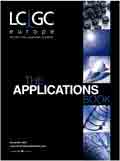Synthesis Quality Control Using an Ion Trap Mass Spectrometer
Improvement of reaction yield and chemical compound purity checks are typical control tasks in chemical synthesis quality control. Since speed is becoming increasingly important, commonly used techniques are becoming more and more overburdened. Thus, fast chromatography coupled with fast and reliable mass spectrometry is highly desirable.
Ralf Ketterlinus and Markus Meyer, Bruker Daltonik GmbH, Bremen, Germany.
Introduction
The amaZon SL ion trap mass spectrometer delivers classleading analytical performance. With high sensitivity — due to its proprietary dual ion funnel technology — and fast data acquisition at superior combinations of scan speed and mass resolution, it delivers uncompromised LC–MSn data quality and flexibility, yet is affordable for any analytical lab. It is the ideal upgrade from single-quad based LC–MS systems to enhance analytical capabilities in synthetic chemistry.
Proprietary easy-to-use OpenAccess software provides walk-up access for multiple users and automated calculation of compound yield and purity, as well as identification of target compounds.
Glycan Structure Elucidation
Making use of the MSn capabilities of the amaZon SL, compound analysis is extended far beyond the molecular weight assignment. The complete glycan-structure of Digitonin, a glycoside from Digitalis purpurea, has been directly elucidated down to the initial sugar unit (Figure 1). Not only side-chains can be observed, de novo analysis of molecular structures is also possible.

Figure 1: Elucidation of a complete glycan structure. MSn experiment on digitonin, revealing the detailed structure of this steroid glycoside.
Verification of Expected Analytes
Identification of natural compounds from Myxobacteria was straightforward using MSn library searching. The instrument's highly reproducible MS–MS data generation enables the direct comparison of experimental data with library reference spectra. Furthermore, fast polarity switching allows the unambiguous identification of compounds in both ionization modes. Figure 2 shows the identification of Myxochelin A (negative ion mode) and Myxalamid C (positive ion mode). UHPLC separation was performed in this experiment and the run time was only 15 minutes. Despite the extremely short UHPLC peak width of only 1–2 seconds, the amaZon SL processed the analytes using fast polarity switching in an automatic MS–MS mode and generated high search scores.1

Figure 2: ID of compounds is optimized by fast polarity switching. Library search of compounds in myxobacteria. Fast polarity switching is performed in combination with MSâMS to verify the presence of the expected analytes.
ID of Compounds
Solid samples can easily be analysed without tedious sample preparation using the "direct insertion probe" (DIP). After uptake of the sample into a glass capillary, it is heated and ionized in the APCI source. amaZon's MSn analysis then provides unambiguous identification of synthetic compounds.2
Multiuser Environment
Using OpenAccess software, amaZon SL is ideally suited to a multiuser environment and can be easily run as a LC–MS walk-up solution for users without special training. Using fixed methods and a simplified user interface, chemical synthesis quality control tasks are standardized and easy to set up. Larger batches can be evaluated using a "traffic-light" colour scheme while more details are delivered in a PDF-report (Figure 3).

Figure 3: Walk-up solution: Its robustness and ease of use make the amaZon SL the perfect instrument for fully automated QC. Users work entirely with the OpenAccess wizard and PDF result reports. The colour-coded MTP plate image provides an easy overview of the success rate of the verification.
Conclusion
amaZon SL is the robust all-purpose answer to a wide variety of chemical, environmental and metabolic challenges. It enables rapid and sensitive identification, as well as characterization and structural confirmation of compounds. The instrument delivers verification of molecular structures from combination of MS and MS–MS at remarkable mass accuracy. It is compatible with UHPLC speeds and allows operation in both expert and OpenAccess environments. Pre-defined LC–MS methods and simplified, automated post-processing tools enable quick and accurate data evaluation.
amaZon SL is currently available as an LC–MS–MS PowerPack with a Dionex Ultimate 3000 at a favorable price. Learn more: www.bruker.com/powerpack
Literature:
1. "Zero Delay" Polarity Switching for Ultra-fast MS/MS Screening Applications. Bruker Daltonics Application Note LCMS-51.
2. DirectProbe: Instant answers from solid samples – Redefining the routine analysis of crude synthesis samples. Bruker Daltonics Technical Note TN-39.

Bruker Daltonik GmbH
Bremen, Germany
tel. +49 421 2205 0 fax +49 421 2205 103
E-mail: sales@bdal.de Website: www.bdal.com

Determining the Effects of ‘Quantitative Marinating’ on Crayfish Meat with HS-GC-IMS
April 30th 2025A novel method called quantitative marinating (QM) was developed to reduce industrial waste during the processing of crayfish meat, with the taste, flavor, and aroma of crayfish meat processed by various techniques investigated. Headspace-gas chromatography-ion mobility spectrometry (HS-GC-IMS) was used to determine volatile compounds of meat examined.
Accelerating Monoclonal Antibody Quality Control: The Role of LC–MS in Upstream Bioprocessing
This study highlights the promising potential of LC–MS as a powerful tool for mAb quality control within the context of upstream processing.

.png&w=3840&q=75)

.png&w=3840&q=75)



.png&w=3840&q=75)



.png&w=3840&q=75)















